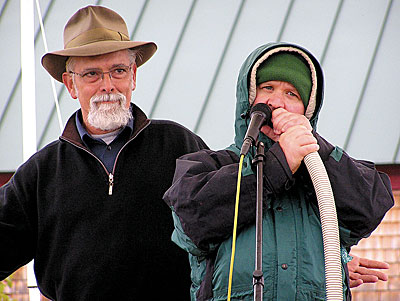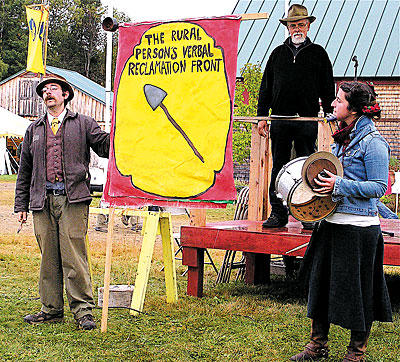 |
| Lynn Miller was accompanied by Jon Fishman of Phish on the vacuum cleaner at the start of his speech at the Common Ground Fair. Miller and others have started a Small Farms Conservancy to promote and protect family farming. English photo. |
Lynn Miller, editor of the Small Farmer’s Journal, gave a surprise speech – accompanied by Vaudevillian entertainers – at the 2009 Common Ground Country Fair. Miller said that he has “taken the draft horse and small farm community around the country, pulled them together, and now embarked on a new adventure trying to get us all to work together to save what’s good, valued and important.” Small farms, that is.
Before launching into his sermon, Miller introduced Jon Fishman, drummer of the band Phish, as “the only living agrarian vacuum-cussionist in the world.” Fishman performed “Staccato in G-flat for the Failed Agrarian” – on a vacuum cleaner.
“I’m sort of embarrassed that I’m using one of the more modern, electric vacuum cleaners,” said Fishman. “I don’t have one of the old horse-powered ones.”
Maintenance and Reclamation Required
Miller then listed human endeavors, including farming as craft, music as thought, fresh local foods, dance as transport, mathematics as mental massage, that are slipping away from us “because we’ve forgotten there are no guarantees … We’re wont to remember that maintenance was required if we were to remain truly humane in the best sense of the word. Humanity’s finest, most magnificent idea of all time was farming.”
The answer to the pressing questions of today – health care, economy, poverty, hunger, environmental degradation, climate change, food safety, education, farmland preservation and more – is small farms, said Miller; farming as craft, as art. “Because at their core, small farms are units of artistry, creativity and biological balance ripe with mystery.”
 |
| Continuing with a vaudevillian theme, Miller invited farmers Rose Friedman and Justin Lander from Modern Times Theater in Vermont to perform as “The Rural Person’s Verbal Reclamation Front.” The two reclaimed the words “chore” and “economy.” English photo. |
He lamented the “hornswaggling” of good words related to farms and food, words that have morphed through neglect and theft. Then, to help “reclaim those words central to our future,” Miller introduced farmers Rose Friedman and Justin Lander from Modern Times Theater in Vermont. As “The Rural Person’s Verbal Reclamation Front,” Friedman and Lander, with wit and song, reclaimed the words “chore,” reminding the audience that the government will not set you free, but chores will; and “economy,” based on the simple currency of two neighbors shaking hands, sharing and helping one another – the handshake economy.
Cutting Out the Cancer of Industrial Agriculture
Miller noted that hundreds of millions of acres of abandoned, arable land exist all over this continent. “We can look at a piece of land and think about how fertile and magical that land had been in the hands of the people who loved it. And at some point it all changed. There is a memory in that land that is a reserve, a bank account; a memory that can allow us a second chance.
“On the other hand,” Miller continued, “industrial agriculture – and I include large-scale organic – functions in a soul-free zone of its own making, a vast, empty room, and those sterile functions in that chamber bring echo to destruction. Echo as an enormous cancer.
“All of biological life on this planet has its own aggregate DNA. As this vast molecular confluence of life, it now plays unwilling host to this cancer of industrial agriculture, the consequences of which have been the destruction of genetic diversity, heightened susceptibility to disease, poisoning of plants, animals and the environment, and the destruction and interruption of life cycles.
“Small farms need an organization of collaborative support, standing visible, unshakeable, definite, watchful, curious, stalwart, malleable and callused in an abiding faith in small farms. For 75 years we’ve lacked the endorsement of an appropriately grateful society. We must return to natural, human scale units of engagement within this biological world – or all will be lost.
“We need more small farms, and we need millions of them, and we need them today. We need to pull our sights in on a target. If you drove into Kansas 20 years ago, you would have seen a sign that said, ‘Every Kansan farmer feeds 68 people.’ Today when you drive in you see a sign that says, ‘Every Kansan farmer feeds 130 people’ – as if that is something to be proud of. That is horrible! It’s criminal! Wholly and completely unsustainable. The ratio must come down and it must come down now – to 30 to 1 or less.”
Fostering 8 Million New Farms
Miller, as part of a new effort called Small Farms Conservancy, believes that we need 8 million new U.S. farms – now.
“What we want to do with the Conservancy is find every creative and imaginative – and yes, even if it has to be illegal – way that we can make it possible for each and every one of you to be farming.”
After two years of working with a dynamic group of people, the Conservancy is now a nonprofit, public-benefit organization with the goals of protecting, sustaining and inspiring small farming worldwide. Among its proposed programs, Miller cited these:
1. Influencing public education on all matters pertaining to small-scale agriculture, through textbook content, curriculum choices and vocational counseling aids, so that kids realize there are more than two breeds of cattle, more than Roundup Ready corn.
2. Pooled insurance for any farmer at a fraction of the current cost; and assistance when a barn burns down or cows need to be milked.
3. Research into retirement programs for small farmers.
4. An apprenticeship clearinghouse linked with farm caretaking services, mitigating or alleviating legal and labor concerns and encouraging progression and learning.
5. Research into micro loans.
6. Placing more farmers on more farms by dividing abandoned large tracts of farmlands into small farm units available to graduate apprentices for lease with an option to buy.
7. Farmers’ legal assistance, with volunteer legal minds giving advice and working on seminal agrarian legal contests.
8. Building a collaborative umbrella under which farms with educational components might share information and services.
9. Creating more local markets for farm produce by aggressively addressing legal impediments and seasonal constraints, and making ourselves aware of efforts like Russell Libby’s work in Washington, D.C., on food safety issues. Working on specific ideas, such as encouraging mobile slaughtering facilities and refrigeration units.
10. Encouraging farmers to formalize their on-farm innovations in ways that the Conservancy and the Small Farmer’s Journal might make available to the public.
11. Protecting farms and farmland through Farms in Trust, a program linking conservation easements, trusts, living wills and other legal instruments to the Conservancy’s farm caretaking educational and apprenticeship programs; and tying the preservation of farmland to the incubation of new farmers.
12. Assisting with end-of-life issues.
13. Enabling the Conservancy to acquire the Small Farmer’s Journal for outreach and to ensure the future of its reader community.
The Farm as Nerve Center
One idea that is not yet part of the Conservancy but has “gotten legs,” said Miller, is the concept of a farm as a nerve center. “Imagine a 200-acre farm in your area that is a working, diversified farm. Perhaps it’s even milking half a dozen cows.
“Imagine that on one corner of that farm you put in an assisted care facility for farmers, so that somebody who’s no longer able to farm and is facing some end-of-life issues, when he’s looking out his bedroom window, [he is] watching the cows go in to be milked,” and his expertise is available when problems occur.
Another corner of the farm would have an educational facility, similar to MOFGA’s, for workshops, demonstrations and test plots.
Yet another corner would have an outpatient clinic to serve all the farms around it.
The fourth corner would have a cemetery, “so that if somebody wanted to be buried where they could see the cows coming in to be milked, there would be a place for that.
“That farm, as a nerve center, would serve to re-knit the community all around it.”
For more information about the Small Farms Conservancy, see www.smallfarmsconservancy.org.
– Jean English
